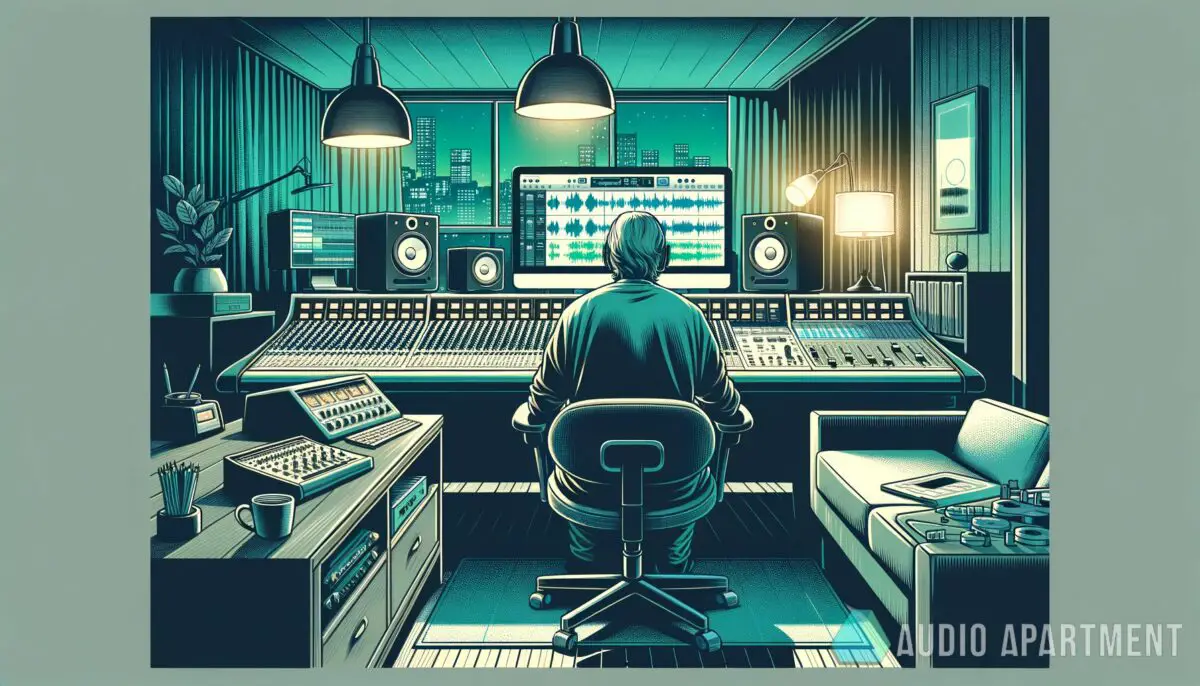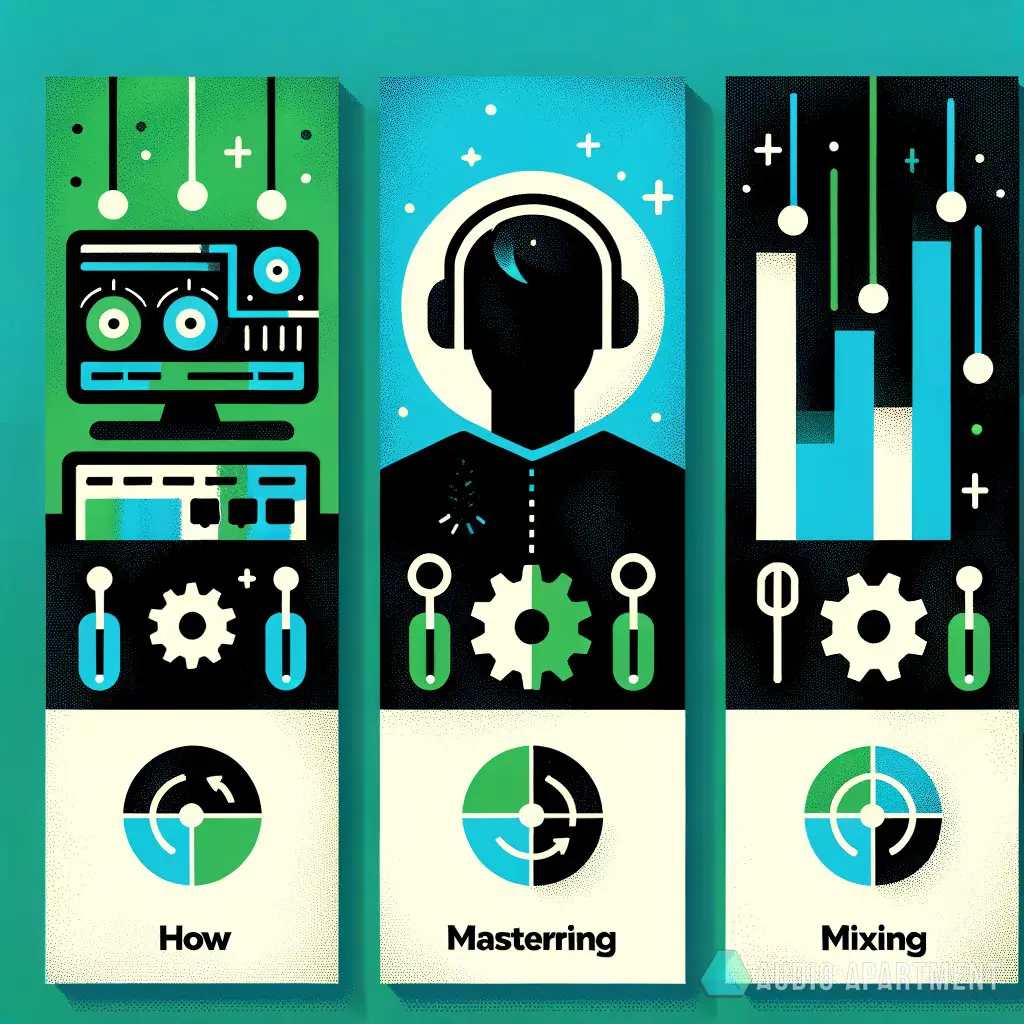Just like knowing the right blend between a smooth whiskey and a perfectly aged wine can make or break a gathering, recognizing the distinction between mastering and mixing is crucial in the music production scene. If you’re curious about setting up your home studio, figuring out these differences is your first step to producing tracks that slap.
Learn more about the best studio headphones to get started. What will you discover? In this post, we dive into the nuances that separate mixing from mastering.
If you are a visual learner, check out this video titled ‘Mixing vs. Mastering (Visual + Audio Explanation)’
Key takeaways
- Mastering is the final touch that ensures your track sounds great across all platforms.
- Mixing is about balance, blending elements for clarity and cohesion.
- Using high-quality plugins and reference tracks can significantly improve your output.
- Feedback and practice are key to mastering the art of mixing and mastering.
How Does Mastering Music Differ from Mixing?
When stepping into the realm of music production, diving into the differences between mastering and mixing is akin to learning the secret ingredients that make your tracks stand out. Mastering is the final touch, akin to polishing a diamond before it hits the showcase, enhancing the overall loudness, clarity, and quality of your track, ensuring it sounds fabulous across all platforms and devices.

In contrast, mixing is where your creativity truly shines. You’re blending all the individual tracks into a cohesive whole.
Here’s a quick rundown:
- Mixing involves adjusting levels, panning, adding effects like reverb and EQ to each element—be it vocals, guitars, drums—to ensure they mesh well together.
- Mastering takes this unified mix, tweaks the final EQ, compresses, limits, and perhaps adds a bit of stereo enhancement or warmth, aiming for a polished, professional end product.
It’s all about balance. Mixing is your chance to ensure every element shines on its own and within the context of the entire track, while mastering ensures that shine translates well across any medium.
In my humble, not-so-expert opinion, the magic of turning a good track into something legendary lies within mastering and mixing’s delicate dance. I remember this old rock documentary where they compared final mixing to painting a masterpiece, and mastering?
That was setting it in the perfect frame to hang in the gallery. It just clicks, you know?
Just like a great bartender knows the exact moment when to stop pouring, a good producer knows how to balance these two. If you’re diving into this headfirst, don’t sweat it if things sound a bit off in the beginning.
Crafting that perfect mix takes time, and nailing the mastering is no small feat. Dive into how EQ shapes your mix for some golden nuggets of info that might just make your tracks shine a bit brighter.
“Diving into the world of music production, mastering, and mixing can seem like navigating a dense forest without a clear path. These tips are designed to be your compass, guiding you toward producing music that not only sounds professional but deeply connects with your audience.”
Let’s vibe with the process and create something that truly slaps.
Continuing from our discussion on the differences between mastering and mixing in music production, let’s dive deeper into specific aspects of the process that can make or break a track. Leveraging our understanding, we’ll explore further into how these phases contribute to the music that moves us.
AKAI Professional MPK Mini MK3

AKAI Professional MPK Mini MK3
Importance of a polished mix
Fine-tuning with Equalization
Equalization (EQ) is essential in mixing for clearing up muddy sounds and ensuring each instrument sits well in the mix. By adjusting frequency bands, producers can eliminate frequency clashes between instruments, making the mix clean and each part distinct.

A well-EQed track can dramatically improve clarity and impact before it even hits the mastering stage. For deeper insights, explore how EQ shapes your mix.
Achieving dynamics with Compression
Compression is another tool wielded during mixing to control the dynamics of a track. By narrowing the range between the loudest and quietest parts, compression helps in achieving a consistent sound level, crucial for both individual tracks and the mix as a whole.
However, overcompression can lead to a lifeless sound, highlighting the importance of balance and subtlety in this process.
Mastering’s role in music distribution
Standardization across platforms
Mastering ensures that your track sounds its best on any device or platform—be it giant club speakers or tiny smartphone speakers. This involves limiting to achieve optimal loudness without distortion, crucial for streaming platforms like Spotify and Apple Music, which have specific loudness standards.
This stage ensures uniformity and quality control that your track needs to stand out.

The final metadata addition
In mastering, metadata—the information embedded in a file that includes artist name, track title, and copyright information—is also added. This not only aids in the organization but is crucial for digital distribution and ensuring artists get credited and compensated for their work.
This detail, though small, plays a significant role in the music industry’s digital ecosystem.
Given the focus on delivering the best possible audio experience and ensuring tracks are ready for distribution, let’s look at some data that highlights the impact of professional mixing and mastering.
| Aspect | Mixing | Mastering |
|---|---|---|
| Main Focus | Balancing and blending tracks | Final polish and loudness |
| Tools Widely Used | EQ, Compression, Reverb | Limiters, EQ, Stereo Enhancement |
| Objective | Clarity and Cohesion | Consistency across platforms |
| Importance in Production | Essential for sound design | Crucial for distribution |
This table underlines the distinct roles mixing and mastering play in music production, emphasizing their complementary nature. Mixing lays the foundation with a cohesive sound, while mastering builds upon this to prepare the track for the world.
Both stages are pivotal in turning a good track into a masterpiece that resonates with listeners everywhere.
Diving into the world of music production, especially mastering and mixing, can seem like navigating a dense forest without a clear path. To help you find your way and to ensure your tracks not only shine but resonate across platforms, here are some fundamental dos and don’ts.
These tips are designed to be your compass, guiding you toward producing music that not only sounds professional but deeply connects with your audience.
| Do | Don’t |
|---|---|
| Do use reference tracks. Comparing your mix to professionally mixed and mastered tracks can provide you with a valuable benchmark. | Don’t overcompress. While compression is crucial, too much can suck the life out of your mix. |
| Do maintain headroom in mixing. Leaving enough dynamic range for mastering ensures clarity and prevents distortion. | Don’t neglect room acoustics. Mixing in a poorly treated space can lead to inaccurate sound judgments. |
| Do apply EQ with intention. Use equalization to clear up muddy sounds and ensure every instrument sits well in the mix. | Don’t rush the process. Rushing through mixing and mastering can lead to missed details and a less polished track. |
| Do consult with a mastering engineer. Their expertise can bring a fresh perspective and polish to your track. | Don’t ignore metadata. Metadata is crucial for distribution and ensuring you get credited for your work. |
More mastering tips
Stepping up your game in mastering doesn’t just stop at following the basic dos and don’ts. Mastering is an art form that requires patience, a keen ear, and continuous learning.
Here are a few more tips that can elevate your mastering game:
- Experiment with stereo imaging. Proper use of stereo imaging can add depth and richness to your track, making it feel more alive.
- Keep up with loudness standards. Different platforms have specific loudness requirements. Familiarize yourself with these to ensure your music performs well across all channels.
- Use high-quality plugins. When it comes to mastering, the quality of your tools matters. Invest in the best plugins you can afford for EQ, compression, and limiting.
- Seek feedback. Getting feedback from fellow producers or a mastering engineer can provide new insights into your work, revealing both strengths and areas for improvement.
- Dedicate time for A/B testing. Regularly compare your mastered track with your unmastered mix and reference tracks. This can help you gauge your progress and understand the impact of your mastering decisions.
By adhering to these guidelines and continuously honing your skills, you’ll be well on your way to producing tracks that not only sound stellar but deeply resonate with your audience. Remember, mastery comes with practice and patience, so keep experimenting and learning with every project you undertake.
Frequently asked questions (FAQ)
How long does it typically take to master a single track?
Mastering a single track can vary in time, largely depending on the complexity of the mix and the specific requirements of the project. Typically, it can take anywhere from an hour to several hours per track.
The key is not to rush the process, as mastering is the final step in ensuring the track sounds perfect on all playback systems.
Can I master a track using only headphones?
While you can technically master a track using headphones, it’s generally recommended to use studio monitors for most of the mastering process. Headphones can be useful for checking details and ensuring there are no issues missed by monitors, especially in the low end, but monitors provide a more accurate representation of how sound interacts in a physical space.
Is mastering necessary for every track?
Yes, mastering is an essential process for every track that is intended for public release. It provides the final polish, ensuring consistency across the album and compatibility across various listening platforms and devices.
Skipping mastering could result in tracks that sound amateurish or uneven when played back to back with professionally produced music.
Final thoughts
As we wrap up our journey through the nuances of mastering and mixing in music production, it’s crucial to remember the importance of these final steps in the music-making process. Mastering and mixing are not just technical necessities—they are the art of bringing your music to life, ensuring it reaches the audience in the best possible form.
Whether you’re an aspiring producer or a seasoned pro, grasping these concepts can elevate your music, ensuring every track you produce slaps in all the right ways.
Did I cover everything you wanted to know? Let me know in the comments section below.I read and reply to every comment.If you found this article helpful, share it with a friend, and check out my full blog for more tips and tricks on mastering and mixing. Thanks for reading and keep creating!















